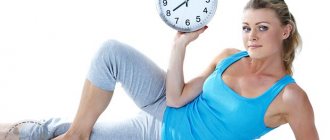Greetings to you, reader of my blog!
Jogging is a type of running exercise that even a beginner can master. It is important to control your heart rate and breathing to achieve the desired result of weight loss. In addition, this running is very beneficial for the overall health of the body, heart, joints and blood vessels.
Running at what speed can be called a “jog”? No specific data. We cannot name the speed at which running is considered relaxed. Of course, this depends on the physical fitness of the runner. From time to time, the distance “covered” by running can be relaxed by walking at the same pace.
The difference from walking is that during running there is still a flight phase, that is, the moment when both feet are off the ground and not touching it. This type of exercise may be ideal for you if you run at a pace of 6-7 minutes per km - for most new runners.
Jogging is synonymous with jogging, sometimes also called slow running. In fact, speed is subjective. More modern sources believe that this is running at the lower limit of the aerobic zone, not even high-speed, and not just fast walking.
Who is jogging suitable for?
There are several categories of people for whom jogging is suitable:
- Novice athletes;
- After injury;
- Full;
- Children;
- Elderly people;
- In the 1st month of pregnancy.
This type of running is universal and has no contraindications, with rare exceptions. In some cases, slow running is allowed with 1st degree flat feet, which allows you to strengthen the muscles of the arch of the foot and stop the progression of the disease. It is not recommended to run if you have serious diseases of the cardiovascular system or heart. In addition, with grade 1 mitral valve prolapse (MVP), exercise is allowed up to professional sports.
Despite the ease of jogging, it is included in the sports training program in the highest categories. Slow running speed increases the load on the muscles, which not only increases strength, but also reduces weight.
Jogging at a leisurely pace is often used during warm-up because it uses not only the leg muscles, but the entire body, including the internal organs and central nervous system. In addition, while running, you can perform additional warm-up exercises (arm rotation, knee raises, etc.).
How to start?
From words to actions or how to approach jogging correctly, we will tell you in 5 points, each of which must be given attention. If you strictly follow the recommendations, then jogging will bring tangible results much faster.
Turn to your health
Every trainer will say that before using physical activity, you need to know the state of your health. Health problems can not only nullify all efforts, but also cause a lot of trouble. If you have known diseases or suspect their presence, then before starting classes it is strictly recommended to consult a specialist.
If there are no health problems and there is no reason to see a doctor, then try to monitor two main health indicators: pulse and blood pressure. Fitness bracelets with an additional heart rate measurement function, for example Xiaomi Mi Band 1S pulse (what I use myself), will help you cope with the task. Measure your heart rate in the morning and evening, as well as before and after your run. This will help identify heart problems that may only appear with sufficient exercise.
We also recommend measuring your blood pressure at least once a day. Remember that the average difference between the upper and lower pressure should be 40 units.
Start with a warm-up
Despite the fact that jogging is often itself a means of warming up, we recommend performing a set of several exercises immediately after you start running.
- Perform circular rotations with your arms forward and backward 4 times in each direction. Repeat the exercise 5-8 times.
- Perform opposite movements with your hands (left forward, right backward). After 8 rotations, change direction. Repeat 2-4 times.
- Run, raising your knees high for 10-15 seconds.
- Swinging the shin back, same time.
- Running with straight legs forward – 10-20 seconds.
A simple set of 5 exercises will help shorten the run-in period and increase the useful part of your run. Also, exercise 2 will help concentrate attention and engage the nervous system in the active work.
Running technique
Performing technical elements when jogging is characterized by a low range of motion. During motor processes, muscles that are not involved in active work should be in a relaxed state.
While running, the arms are bent at the elbow joint 90 degrees. Hand work is performed by inertia and does not require accentuated work. The shoulder girdle is in a relaxed state. The gaze is directed 10-15 meters ahead. This position of the upper limbs and head will ensure minimal energy expenditure, which will allow you to run a greater distance.
Hand movements occur along the ribs or forward-inward, back-outward. When moving the arm forward, the hand reaches the middle of the chest or solar plexus. The abduction ends when the hand remains in the area of the ribs.
The body is in an upright position and only slightly tilted forward by 5-7 degrees. When running, oscillatory movements in the vertical and horizontal projections should be minimized.
Turning right or left sideways forward is highly undesirable. When running, the shoulder line should be straight. Otherwise, the technique is disrupted, which leads to a decrease in the efficiency of movements and the applied efforts are less beneficial. If the turns of the body are significant and resemble rocking, then there is an excessive load on the lumbar region and, as a result, pain after training.
Monitor your breathing and pulse
Breathing and pulse are indicators that can signal the body’s reaction to the load received. If after the start of the run the indicators rise sharply, it means that the pace is set high and you should slow down a little.
After you start running, your heart rate always increases significantly, but after a few hundred meters of steady running, you may find that it has become lower. This indicates a normal response to physical activity.
Since jogging is recreational, the recommended heart rate is in the range of 120-140 beats per minute. By adhering to the proposed range, you can be sure that the body will adequately perceive physical activity and the response will be positive.
An increase in breathing rate is always correlated with heart rate. If you perform several quick breathing cycles while sitting on the couch, you may notice an increase in heart rate and upper blood pressure.
The recommended breathing rate during slow running is one inhalation or exhalation for every 4 steps. This figure may vary depending on lung capacity. If jogging is systematic, the breathing rate will decrease and reach 5-6 steps per inhalation or exhalation, which will indicate lung training.
Try to breathe comfortably. If during jogging it is not enough for you to inhale or exhale every 4 steps, then breathe more often. Don’t try to adapt to the norms, anyway, after a while you will surpass them.
Choose the right shoes
Properly selected shoes will help you get the most out of your jogging. Remember that running shoes are the best option. The use of sneakers or other sports shoes is not recommended due to the lack of shock-absorbing soles.
Shock absorption helps protect the knee joints from damage due to the impact force of landing. Additionally, the shock absorption promotes forward movement due to the spring effect, and also guarantees traction with the surface in the presence of deep treads.
When choosing sneakers, pay attention to their weight. The average weight of one sneaker should not exceed 500 grams. We recommend giving preference to shoes whose soles are made of helium material. Foam sneakers are also a good option, but such material becomes hard over time and the shock-absorbing effect is lost.
Using the recommendation will help you avoid unpleasant consequences, and will also increase the impact of each run. Exercise correctly and systematically and remember that there is no more universal remedy than running.
Benefits for weight loss
If you decide that running won't help you achieve your weight loss goal, you're jumping to conclusions! In fact, this is one of the best types of physical activity that allows you to lose weight quickly. Of course, if running becomes a habit and with proper nutrition. If you remember, when jogging, the speed is only 8 km/h, which means that the runner is not very tired and can withstand long periods of exercise.
Meanwhile, it is known that during the first 40 minutes of training, the body extracts energy from glycogen, which accumulates in liver cells, and the latter begin to become fatty. And to lose weight, you need to run for at least 40 minutes, and better yet, an hour and a half. This type of running allows a person to endure long periods of physical activity.
Keep in mind that the weight loss process starts quickly and lasts a long time, but it is important to keep your diet under control. Food with less energy than required for normal life (which, by the way, consumes a lot of energy). In this case, the body will begin to burn its accumulated reserves - fat, and you will end up fitting into your favorite jeans.
Exercise 3 times a week and drink plenty of water.
How many calories does running burn?
- When jogging, up to 400-500 kcal are consumed. In one hour.
- Running in place burns up to 400-500 kcal/hour.
- When walking - up to 200-250 kcal.
- When warming up - up to 600-700 kcal per hour.
Burning calories seems to be motivating. This depends on the duration of the exercises, the pace of movement, and the accuracy of the sessions.
The benefits of trotting for men and women
And yet, the health-improving effect of slow cardio training has long been recorded and accepted as a fact by all scientists and doctors. Let's consider what positive processes occur when playing sports:
- reducing body weight by burning calories - a deficit appears, you have to spend energy reserves, which are stored in fat deposits;
- endurance increases after long runs;
- blood vessels dilate and are cleansed of toxins and waste, reducing the possibility of blockage, thrombosis, and plaques;
- the heart muscle becomes more elastic, works more intensely, and can overcome greater loads;
- the muscular frame becomes stronger, this is especially important for the back, since its work reduces the weight that the spine usually bears;
- the muscles surrounding the internal organs are also strengthened, this leads to a reduced risk of prolapse of the liver, spleen, and kidneys, as well as to their more efficient functioning;
- metabolism improves, so the absorption of all microelements and vitamins obtained from food is much more productive;
- the immune system becomes stronger, colds and infections cause less damage to health;
- stress is relieved, due to the production of happiness hormones, the athlete’s psycho-emotional state generally improves, and seasonal depression recedes;
- all cells are saturated with oxygen, since it is transmitted along with the blood, and with an increased heart rate, active blood circulation occurs - even small vessels receive new blood;
- internal reproductive organs become more active due to the work of the abs, buttocks, as well as movements leading to the activity of the small pelvis;
- The volume of the lungs increases, they are cleansed and open to full capacity;
- fatigue decreases, cognitive abilities and memory, attentiveness and perseverance increase;
- the musculoskeletal system is strengthened, all joints receive natural lubrication, are developed, and warmed up.
Thus, jogging with the correct technique has a healing effect on all aspects of a person’s life without exception - from physical health to psychological state.
There are also positive changes in a runner's daily life. He becomes more responsible and disciplined, and due to efforts on himself, self-confidence and self-esteem increase. However, most smokers quit the habit when they start exercising and generally begin to lead a healthier and more active lifestyle.
The harm of jogging
Every coin has two sides, and jogging is no exception. The benefits of jogging are certainly great, but if done incorrectly, it can cause more harm. Running is actually harmless.
Contraindicated for people with severe heart disease. In many cases, the cardiologist may prescribe jogging, but if running in any form has been prohibited, then this must be carried out unconditionally. You can harm your heart in this way.
Improper running technique can damage joints, ligaments and muscles. First of all, this applies to the legs. You should avoid running heel-to-heel to reduce the impact load on your feet and knees. If the feet do not rise parallel to each other, the periosteum and knees will suffer.
Periodic running in heart rate zones cannot be called running. Such running will only harm the heart and the entire body. Do not exercise while overtraining.
Even a professional athlete won't run late at night after a long day of work. This is best done after rest and sleep. All classes must be completed by 8:30 pm and begin no earlier than 6:30 am. During this period, the body needs rest.
What it is?
What speed of running can be called “jogging”? There is no specific data that would allow us to define this run as such. We don’t know the speed, so what kind of running is considered relaxed? Obviously depends on the physical fitness of the runner. Sometimes they say that the distance “run” by jogging can be quite calmly covered on foot, at the same pace.
The difference from walking is that running still has a flight phase, that is, the moment when both feet are off the ground and not touching it. This type of load can be well imagined if you run at a speed of approximately 6-7 minutes per 1 km, for most novice runners.
Jogging is synonymous with jogging, sometimes also called slow running. Actually, speed is subjective. More modern sources on running believe that jogging is running at the lower limit of the aerobic zone, not yet fast, but no longer just fast walking.
Running Clothing and Shoes
Let's compare the run and the weather conditions.
Of course, clothing will depend on the season. In summer - sneakers or sneakers with comfortable soles. Running in very springy running shoes is difficult, but not impossible. By the way, be careful about your shit. Rubber or natural carving outsoles are best.
Jogging through wild fields is strictly not recommended, since all sorts of surprises can be hidden in the grass in the form of holes, biological waste, and more. Asphalt is not the best option. This coating is quite hard and can be hard on your joints.
You need to dress in a comfortable training suit. Running is a long exercise. Be prepared to protect yourself from mosquitoes if you are running in a park or on a forest trail.
During the hot season, it is important not to overheat, since you move intensely while running. And in the cool season, it is important not to overheat and freeze. Everything is more difficult here than in the summer. It is important to choose clothes that will breathe and keep you warm.
Typically, several layers of fabric help achieve this goal. That is, you have a T-shirt on your body, then a trowel and a light jacket. The airbag between the layers of fabric prevents freezing, while there is ventilation.
We do not recommend running in rain or ice - you may fall. In cold weather, be careful, you may get frostbite. For example, on the face or fingers. Since your feet will be moving, they won't get cold, but be sure to pay attention to their thermal comfort.
It is impossible to run in synthetic clothing that does not allow air to pass through, in rubber shoes or barefoot. You can step on glass with your bare feet and get injured.
Who can run?
Only absolutely healthy people can exercise regularly without medical supervision. If you have acquired or congenital heart disease, diabetes, hypertension, vision problems (changes in the retina), then be sure to go to the doctor for a consultation. This cannot be neglected, because few people know about all their illnesses. For most people, a minimal screening (ECG, blood pressure, cholesterol and blood sugar levels) will be sufficient.
Where to start jogging
It is recommended to prepare for a run. It is necessary to exclude problems such as shortness of breath, pain in the sides, sprains. A person who has not previously done any sports should do more exercises before running, combined with various types of walking.
For example, you can walk first on your heels, then on your toes, then walk with your hands in different positions: behind your head, on your shoulders, on your belt, etc. Next, it is recommended to start a simple warm-up. These include swings, light push-ups, squats, and swinging your arms and legs. This way you can improve your blood circulation and avoid damaging your muscles and joints while running.
Training plan for beginners
When starting to train according to the given scheme, keep in mind that only a personal trainer can recommend an exact exercise schedule. Average data shown. Each body is individual, you need to approach sports carefully, listening to yourself. If you have any illnesses, pregnancy, or older people, you should consult a doctor.
Tab. A
| Day of the week | Jogging | Quick step | Number of repetitions |
| Monday | 1 min. | 1 min. | 10 |
| Wednesday | 2 minutes. | 2 minutes. | 5 |
| Saturday | 2 minutes. | 1 min. | 7 |
Tab. B
| Day of the week | Jogging | Quick step | Number of repetitions |
| Monday | 3 min. | 2 minutes. | 5 |
| Wednesday | 4 min. | 2 minutes. | 4 |
| Saturday | 5 minutes. | 2 minutes. | 4 |
Tab. IN
| Day of the week | Jogging | Quick step | Number of repetitions |
| Monday | 7 min. | 3 min. | 3 |
| Wednesday | 10 min. | 3 min. | 2 |
| Saturday | 10 min. | 3 min. | 3 |
How to jog correctly - running technique
Running is not like a sport. It is easier. The step length is 60–80 cm at a speed of 7–9 km per hour; when the speed changes, the step length also changes. Keep your body in an upright position. Place your feet on your heels and roll evenly on your toes. Keep your elbows close to your body and bend your arms. Hands into a fist, relaxing the muscles of the shoulder girdle.
IMPORTANT !
- At first, it is better to start running alone. When you run alone, you pace yourself and listen to your body.
- Exercises are performed to load strength during the working day; if you see lethargy or drowsiness, then this is a sure sign that you should reduce the load.
- No need to run to work, every day and monotonously. Running is just for fun.
How to control the pace
Running exercises require low activity, but the load must be felt to have a positive effect.
Too low a load will not allow the heart muscle to fully pump blood, saturating the body with oxygen and necessary substances. There will also be no acceleration of metabolic processes, which many runners strive for. What to focus on?
Pulse. Try to keep control by focusing on your heart rate.
Since running is part of a recreational activity, the recommended heart rate is 120-140 beats per minute. In an untrained person, even slow running causes such a pulse, while in an athlete, light running accelerates the heart rate to 105-110 beats per minute. According to statistics, at 50 years of age, 140 beats per minute is achieved with the same tension that in people aged 20 to 25 years leads to an increase in heart rate to 120 beats per minute.
145-165 beats is already a training frequency. This pace is suitable for those looking to build endurance after preparing the body for less stress. At this speed, the body's correction begins because the aerobic threshold has been exceeded.
Breath. To know if the speed is correct, you can breathe. It is believed that if a person can have a discussion while running, then everything is in order. That is, the person speaks sentences rather than giving short answers to yes/no questions. On the other hand, when you're running at that pace, it's hard to sing and stretch out your notes. If a person can sing, it's time to speed up.
To determine when you need to increase your speed, try working at maximum strength for a few minutes. Very soon the breathing will become faster and the pace will be lost. It is important to try to maintain an average running speed so that your breathing is smooth.
What is jogging?
Jogging (jogging) is suitable for both young and old people, due to its moderate speed of 7 to 9 km per hour on average. The duration of the run, as well as the speed, can be chosen by the person himself, choosing the optimal conditions for himself. This type of aerobic physical activity will be useful for both a beginner athlete, a housewife or even an elderly person, as well as a professional athlete, an employee of a special unit, or an overweight person.
Duration, speed and conditions may vary according to the runner's wishes. So, for example, by inserting the player's headphones into his ears and leisurely walking along the paved path of a residential area, a person can receive a daily boost of energy, strengthening all systems of the body.
Jogging in the army is another matter when, having risen before dark, the company begins to move in pouring rain and heavy winds, hiding behind a mountain pass at an altitude of two and a half kilometers above sea level. With noticeably thin air and constant ascent with full gear. Both the first and second examples will be the same jogging.
The average recommended running speed does not mean that the pace cannot be kept below 7 km/h. On the contrary, you need to train in your comfort zone , even if the average speed is 4 - 5 km/h.
If you have shortness of breath, pain in the side and general fatigue, you can reduce your speed or start walking. After regaining your strength, you can increase the pace again.
Also, with such loads, you can change the angle of inclination , run uphill or on uneven surfaces, the number of calories burned will increase, and body weight will decrease faster, even at a low pace.
Where to jog: outside or on a treadmill
The treadmill cushions and removes up to 40% of the load from the knees and spine. The presence of the simulator does not interfere with people and cars, just as it does not happen while jogging on the street or in the park. The advantages include the lack of dependence on the weather.
But the weather is a huge minus. While running in the gym, the athlete receives less oxygen, does not overcome wind resistance, reduces the load and does not allow training coordination and the nervous system.
The big drawback of the simulator is the lack of pushing the body forward. Work on the gluteal muscles is minimized, and the quadriceps muscles (the front of the thigh) are subjected to heavy load. An athlete who runs 20 km on a simulator is unlikely to be able to cover this distance on the street.
Comfort is not always useful. Studies conducted to analyze overall biomechanics and oxygen metabolism in the body confirm that the treadmill is not a substitute for outdoor running.
How much and when to run
It is preferable to run for 40 to 60 minutes 2-3 times a week. During the first 40 minutes, the body extracts energy from glycogen, an easily digestible sugar stored in the liver, to fuel muscles. Only when glycogen is used up does the body begin to draw energy from fat reserves.
This happens 10-20 minutes after a 40-minute run. After an hour, it becomes difficult for the body to maintain its energy needs, and it begins to obtain energy from muscle protein, which is best avoided. If you want to preserve muscle, long runs are not the best option.
American scientists conducted a study and found that level 1 of physical fitness (running, cycling, swimming, aerobics, etc.) is best done from 7 a.m. to 5 p.m. until 1 p.m. Athletes who do cardio at night have a 65% higher metabolic rate.
Nevertheless, experts advise trying to run at different times and choosing the best option. If you're not training for a race, you can run at your current pace for fun.
To avoid insomnia, run 3-4 hours before bed. Don't run on an empty stomach - eat at least one banana. Eat a lean protein with fiber 1-2 hours after your workout.











